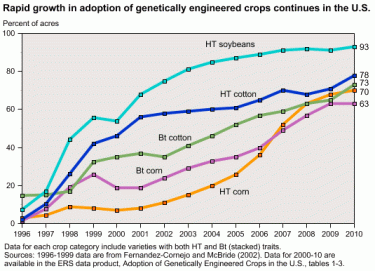
GMO or non GMO? That is the question….
Lately, GMO products have been hit with some bad publicity. I recently went to a local grocery store in Palatine, Illinois and took a photo of this USDA Organic certified wheat package. In case you can’t see it, this is a whole wheat Gemelli brand wheat product with the fancy USDA Organic logo. However, an organic label alone does not guarantee that you are getting a non GMO product.
What’s the Difference?

The difference is what each of these terms describe. The term organic is used to define how a product is grown. GMO and non GMO are adjectives that describe whether the product is genetically altered in some way. GMO stands for Genetically Modified Organism. An organism that is genetically modified can still be grown organically.
GMO plants have their genetic code changed in a way deemed beneficial by scientists, not by nature. Before 1997 the USDA Organic label did not specify whether or not the produce grown organically was non GMO or if GMO plants needed to be excluded from the definition of organic. Over the years the USDA has changed it’s stance.
The USDA government website states that,
USDA organic standards describe how farmers grow crops and raise livestock and which materials they may use…
These standards cover the product from farm to table, including soil and water quality, pest control, livestock practices, and rules for food additives.
Organic farms and processors:
- Preserve natural resources and biodiversity
- Support animal health and welfare
- Provide access to the outdoors so that animals can exercise their natural behaviors
- Only use approved materials
- Do not use genetically modified ingredients
- Receive annual onsite inspections
- Separate organic food from non-organic food
These standards specifically state that USDA certified organic products are in fact non GMO products as well. This is not necessarily true for all organic standards and certainly has not been true at all times in the past.
According to NewHope360.com,
In 1997, the U.S. Department of Agriculture (USDA) released its draft National Organic Program rule. At this time, they proposed that organic allow the use of GMOs. This proposal was unacceptable to consumers, manufacturers, retailers, farmers, and basically anyone who had anything to do with organic.
The battle ended with consumers and farmers reigning victorious.
The final rule outlines that an organic operation has to document that it has not used GMOs and takes reasonable steps to avoid contact with GMOs. Whether a product is labeled “100% organic,” “certified organic” (with an allowance of 5% non-organic ingredients) or “made with organic” (a minimum of 70% organic ingredients), none of the ingredients are permitted to use genetic engineering.
That means in a “made with organic” cereal containing 70 percent organic ingredients, the remaining 30 percent non-organic ingredients cannot be produced from genetic engineering. Providers of non-organic ingredients being used in organic products, must also be able to provide proof that their ingredients are non GMO.
So the USDA Organic certification on a product is the government’s guarantee that these products will contain only non GMO ingredients. If you want to avoid GMO products and go only for the non GMO, then this is as sure of a bet as you can get at the grocery store.

How To Tell If A Product is Non GMO
If you don’t want to buy exclusively USDA certified organic products but would still like to eat non GMO foods there is another way to go about your grocery shopping. It is common for produce to use short numbers called PLU codes, or price-look-ups, to indicate what kind of product is behind the label. It can be used to indicate manufacturer, color, etc. It is often used to indicate growing conditions. The major benefit of the PLU system is that each PLU code is unique to each product, regardless of where you buy it. This is key for those people going the non GMO route.
The PLU Code user guide states that:
The IFPS shall be responsible for deciding the assignment and definition of qualifying prefix digits
for international recognition. At present, only three digits have been allocated:0 Applies to all non-qualified produce and is generally presented without the leading
“zero” digit.
8 Genetically modified
9 Organic
This means that if the PLU code is five digits the first digit indicates organic or genetically modified, but it is not mandatory for the producer to specify if they do not want to. If the PLU code is four digits, then PLU code will not indicate whether the product is GMO or non GMO. While it is not currently a requirement in the United States to label GMO produce, in the USA and Canada, food manufacturers are not allowed to label their food as 100% organic if any GMOs are used. To be 100% certain that your food is organic: look for an organic label, a 9 at the beginning of a 5 digit PLU code, or just grown your own.
Sources:
NewHope360.com- USDA says “organic” means “non GMO”
USDA.gov- National Organic Standard
International Federation of Produce Standards
IFPS- Produce PLU Codes User Guide
Organic 101: Can GMOs Be Used in Organic Products?



